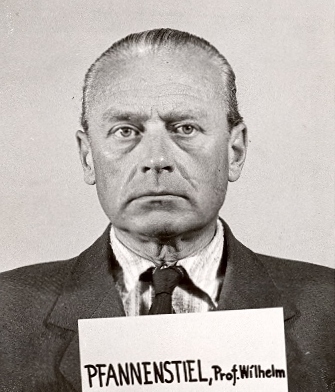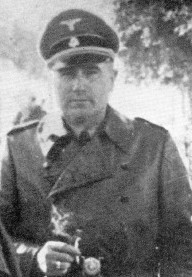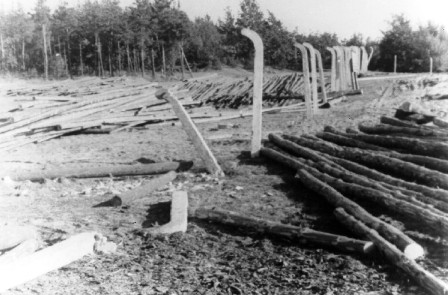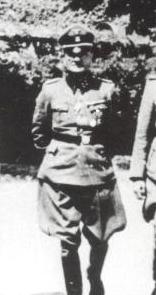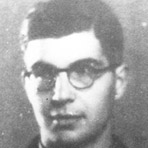Holocaust Education & Archive Research Team |
|
Belzec
Belzec Images Transports Belzec Articles ---------------------------
A-R Leadership
A-R Articles
Action Erntefest Modern Research | ||
Wilhelm Pfannenstiel Witness to the Exterminations at Belzec
During the First World War I was an air force officer and was demobilised as a first lieutenant in the reserve. In 1936 I successfully completed reserve training as a sanitation officer in the army and was promoted to Oberstabsarzt in 1939.
From 1930 up to this time (1939) I held a chair in Hygiene and Bacteriology at the University of Marburg and was at the same time director of the Institute of Hygiene in Marburg. This was a normal professorship I retained this professorship up until the end of the war.
At the end of 1939 I was called upon by the Waffen- SS to work for them as a consultant hygienist. At that time the Waffen-SS having expanded considerably as a result of the war, needed medical experts to work for them in an advisory capacity.
On a visit to Berlin at the end of 1939 I got in touch with the then Corps Doctor of Waffen-SS, Dr Dermietzel, who asked me to serve as medical advisor with a rank of SS- Sturmbannfuhrer. I already knew Dr Dermietzel from my time as SS- Oberabschnittsarzt in Oberabschnitt Fulda – Werra.
In April 1940 I was then called up by the Waffen-SS and given a posting as consultant hygienist. My assignments mostly took place when there were no lectures. My work entailed inspecting, checking and improving the sanitary facilities at all the different places where the Waffen-SS was stationed and to combat epidemics.
For this reason I visited the city of Lublin and the surrounding area in 1942. I had already been in Poland since 1940 in my capacity as hygienist. I was however, always at each place for just a short time, after which I would return to the university in Marburg.
According to the available documentation, I was in the city of Lublin for the first time in August 1942 , it was here that I met SS-Gruppenfuhrer Globocnik for the first time. At the time there were plans to build a large concentration camp on the outskirts of the city of Lublin, capable of holding about 150,000 people. I visited the site to advise on the sanitary installations which were being built, provisions of drinking water and sewage drainage.
I did not have any contact with the occupants of the concentration camp or the worker columns. I remained only a short time in Lublin as my assignment in connection with the concentration camp was finished.
I naturally had other assignments in the area around Lublin which were also related to sanitary measures. After I had finished this work I returned to Marburg to the university. My instructions always came from Berlin, from the Sanitation Office of the Waffen-SS. I also spent some time in Berlin in order to be on call for short term assignments. My own permanent place of residence was and always remained Marburg.
When I am asked about executions of Jews I must confirm that on 19 August 1942 I witnessed an execution of Jews at Belzec extermination camp, I would like to describe how I came to be there.
During my conversations with SS-Brigadefuhrer Globocnik, he told me about the large spinning-mills that he had set up in Belzec. He also mentioned that work at this camp would considerably outstrip German production. When I asked him where the spinning materials came from, he told me proudly that they had been taken from the Jews.
At this point he also mentioned the extermination actions against the Jews, who for the most part were killed at the camp at Belzec. Around the same time Globocnik had asked a certain SS-Obersturmfuhrer Gerstein, while he was in Lublin, how these large mills could best be disinfected.
Gerstein was also a member of the Sanitation Office in Berlin, he had recommended a certain substance, which could be sprayed on the individual layers of clothes. I personally had not heard of this substance. Globocnik also asked me for advice on the matter. I told him that the best thing for me to do would be to have a look at the workshop itself. I visited the camp and established that it was in an orderly condition, had clean sanitary facilities and had about 1,000 Jewish detainees.
During the first visit I was taken around by a certain Polizeihauptmann named Wirth, who also showed and explained to me the extermination installations in the camp. He told me that the following morning a new transport of about 500 Jews would be arriving at the camp who would be channelled through these extermination chambers.
He asked me whether I would like to watch one of these extermination actions, to which after a great deal of reflection I consented. I planned to submit a report to the Reichsarzt – SS about these extermination actions. in order to write a report I had however, first to observe an action with my own eyes.
I remained in the camp, spent the night there and was witness to the following events the next morning. A goods train travelled directly into the camp of Belzec, the freight cars were opened and Jews whom I believe were from the area of Romania or Hungary were unloaded. The cars were crammed fairly full. There were men, women and children of every age.
They were ordered to get in line and then had to proceed to an assembly area and take off their shoes. I stood a little to the side of this line and watched the proceedings together with Polizeihauptmann Wirth and Obersturmfuhrer Gerstein.
The SS escorts took up guard positions outside the camp and Jewish functionaries from the camp gave the arriving transports to understand that they would now be examined and instructed them to undress so that they could be deloused and take a bath. They also told them they had to inhale in a certain room to prevent them passing on any illnesses through their respiratory tracts.
I could not understand what the Jewish camp functionaries were saying, but Herr Wirth explained to me. After the Jews had removed their shoes, they were separated by sex. The women went together with the children into a hut. There their hair was shorn and then they had to get undressed.
The men went into another hut where they received the same treatment. I saw what happened in the women’s hut with my own eyes. After they had undressed the whole procedure went fairly quickly. They ran naked from the hut through a hedge into the actual extermination centre.
The whole extermination centre looked just like a normal delousing institution in front of the building there were pots of geraniums and a sign saying “Hackenholt Foundation,” above which there was a Star of David.
The building was brightly and pleasantly painted so as not to suggest that people would be killed here. From what I saw, I do not believe that the people who had just arrived had any idea of what would happen to them.
Inside the building the Jews had to enter chambers into which was channelled the exhaust of a 100? HP engine, located in the same building, in it were six such extermination chambers. They were windowless, had electric lights and two doors. One door led outside so that the bodies could be removed.
People were led from a corridor into the chambers through an ordinary air-tight door with bolts. There was a glass peephole, as I recall, next to the door in the wall. Through this window one could watch what was happening inside the room but only when it was not too full of people.
After a short time the glass became steamed up, when the people had been locked up in the room the motor was switched on and then I suppose the stop-valves or vents to the chambers opened. Whether they were stop –valves or vents I would not like to say. It is possible that the pipe led directly to the chambers. Once the engine was running, the light in the chambers was switched off.
This was followed by palpable disquiet in the chamber. In my view it was only then that the people sensed something else was in store for them. It seemed to me that behind the thick walls and door they were praying and shouting for help.
After about twelve minutes it became silent in the chambers. The Jewish personnel then opened the doors leading outside and pulled the bodies out of the chambers with long hooks. To do this they had to put these hooks in the mouths of the bodies.
In front of the building they were once again thoroughly examined and the bodily orifices were searched for valuables. Gold teeth were ripped out and collected in tins. These activities were carried out by the Jewish camp personnel. The bodies were taken from the searching area directly and thrown into deep mass graves which were situated near the extermination institute.
When the grave was fairly full, petrol – it may have been some other flammable liquid – was poured over the bodies and they were then set alight. I had barely established that the bodies were not completely burned when a layer of earth was thrown over them and then more bodies were put into the same grave. During the disposal of the bodies I also established that the whole procedure was not entirely satisfactory from the point of view of hygiene.
Dr Pfannenstiel returned to Lublin as a police decode translated by the British Intelligence Service revealed that Ernst Lerch, who was Globocnik’s adjutant arranged a car for Dr Pfannenstiel on the 30 September 1942. The purpose of Dr Pfannenstiel’s visit to Lublin is unknown.
At his deposition before the Darmstadt Court, June 6, 1950 Dr. Pfannenstiel made the following statement regarding the Gerstein report:
I know that Dr. Gerstein gives an entirely different description of this gassing scene. That version is false. It is full of exaggerations. What is characteristic in this respect is Gerstein's assertion that, in his view, about 25,000,000 people had been subjected to this treatment. As he told me himself on that occasion, he had been to Belzec a number of times. It is possible that he may have witnessed scenes similar to those he describes and that, in his report of April 26, 1945, he was no longer differentiating between the visits, but giving a summary picture of them.
Thus, he mentions a
certain S.S. officer Günter who is supposed to have travelled with us,
but we travelled alone. In other respects, too, the Report is full of
inaccuracies. I maintain especially that I did not say: "as they do in a
synagogue." Even if I should have made such a remark, it was not in the
sense imputed to me by Gerstein, as if to suggest that I was poking fun
at the torments of the prisoners. The situation was much too dreadful
for that.
Source: NARA US National Archives Those Were the Days by Klee, Dressen, Riess, published by Hamish – Hamilton London 1991 Counterfeit Nazi. New York: Knopf, 1969 Saul Freidlander Photograph of Wilhelm Pfannenstiel by Phil S. Stein Holocaust Historical Society Imperial War Museum London The National Archives – Kew London
Copyright James Quinn H.E.A.R.T 2010
|
